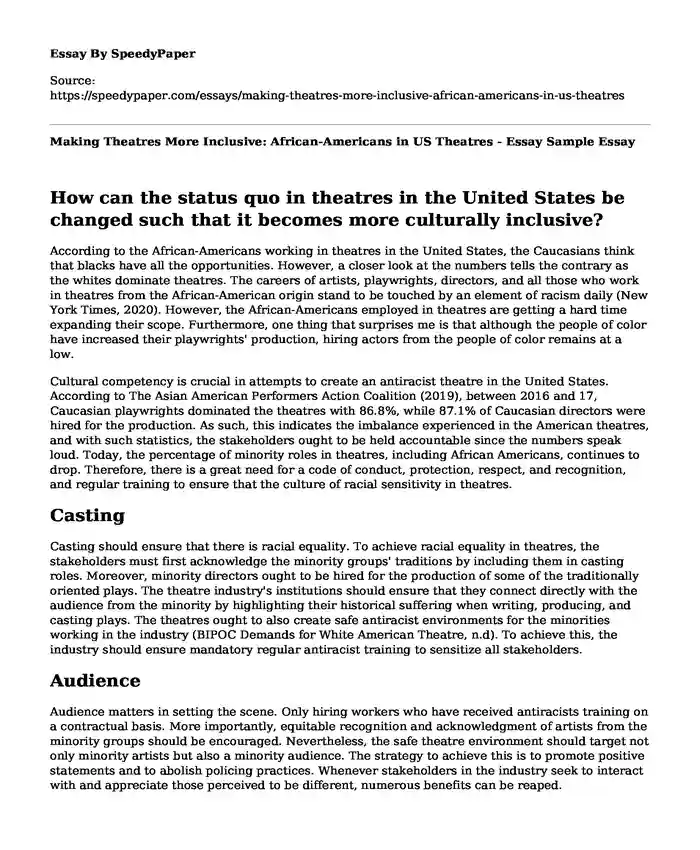
| Type of paper: | Essay |
| Categories: | United States Theatre Art |
| Pages: | 3 |
| Wordcount: | 653 words |
How can the status quo in theatres in the United States be changed such that it becomes more culturally inclusive?
According to the African-Americans working in theatres in the United States, the Caucasians think that blacks have all the opportunities. However, a closer look at the numbers tells the contrary as the whites dominate theatres. The careers of artists, playwrights, directors, and all those who work in theatres from the African-American origin stand to be touched by an element of racism daily (New York Times, 2020). However, the African-Americans employed in theatres are getting a hard time expanding their scope. Furthermore, one thing that surprises me is that although the people of color have increased their playwrights' production, hiring actors from the people of color remains at a low.
Cultural competency is crucial in attempts to create an antiracist theatre in the United States. According to The Asian American Performers Action Coalition (2019), between 2016 and 17, Caucasian playwrights dominated the theatres with 86.8%, while 87.1% of Caucasian directors were hired for the production. As such, this indicates the imbalance experienced in the American theatres, and with such statistics, the stakeholders ought to be held accountable since the numbers speak loud. Today, the percentage of minority roles in theatres, including African Americans, continues to drop. Therefore, there is a great need for a code of conduct, protection, respect, and recognition, and regular training to ensure that the culture of racial sensitivity in theatres.
Casting
Casting should ensure that there is racial equality. To achieve racial equality in theatres, the stakeholders must first acknowledge the minority groups' traditions by including them in casting roles. Moreover, minority directors ought to be hired for the production of some of the traditionally oriented plays. The theatre industry's institutions should ensure that they connect directly with the audience from the minority by highlighting their historical suffering when writing, producing, and casting plays. The theatres ought to also create safe antiracist environments for the minorities working in the industry (BIPOC Demands for White American Theatre, n.d). To achieve this, the industry should ensure mandatory regular antiracist training to sensitize all stakeholders.
Audience
Audience matters in setting the scene. Only hiring workers who have received antiracists training on a contractual basis. More importantly, equitable recognition and acknowledgment of artists from the minority groups should be encouraged. Nevertheless, the safe theatre environment should target not only minority artists but also a minority audience. The strategy to achieve this is to promote positive statements and to abolish policing practices. Whenever stakeholders in the industry seek to interact with and appreciate those perceived to be different, numerous benefits can be reaped.
Building Repertoire
In building a repertoire, I will ensure that I identify myself with the style and genre in the scene. Opening and following up the set will closely depend on the initial step. Making a realistic and exciting list of events to be done will enhance the repertoire. Thinking about the impacts of the events will also add value to it.
One of the main hindrances to creating a theatrical organization characterized by racial sensitivity is the lack of communication between the majority and minority workers. Therefore, the stakeholders from either side should invest in listening and not merely listening to hear but also to understand. Conversations should be conducted in which people from diverse groups share news as opposed to stealing ideas. Lack of collaboration between writers, actors, directors, among others, has also significantly contributed to impeding the efforts to create a racially equitable and antiracist theatre. Finally, most of the industry players also lack proper training on the need for diversity in American theatres.
References
BIPOC Demands for White American Theatre. (n.d).
New York Times. (2020). Four Black Artists on How Racism Corrodes the Theater World. New York Times.
The Asian American Performers Action Coalition. (2019). Ethnic Representation on New York City Stages. The Asian American Performers Action Coalition.
Cite this page
Making Theatres More Inclusive: African-Americans in US Theatres - Essay Sample. (2023, Nov 26). Retrieved from http://land-repo.site.supplies/essays/making-theatres-more-inclusive-african-americans-in-us-theatres?pname=speedypaper.com
Request Removal
If you are the original author of this essay and no longer wish to have it published on the SpeedyPaper website, please click below to request its removal:
- Free Essay for Your Use on the Controversial Fashions and Designs In 2014
- Free Essay Comprising the Latin Music Concert Review
- Essay Example on Effects of Falling Value of Euro
- The Scream by Edvard Munch - Art-Piece Analysis Essay
- Evidence Report on U.S Russia Contact. Free Essay Example
- Music Influence - Free Paper Example
- Social Structures Unveiled: Essays on Wealth, Class, and Mobility in the United States - Report Sample
Popular categories




